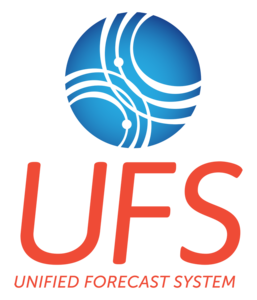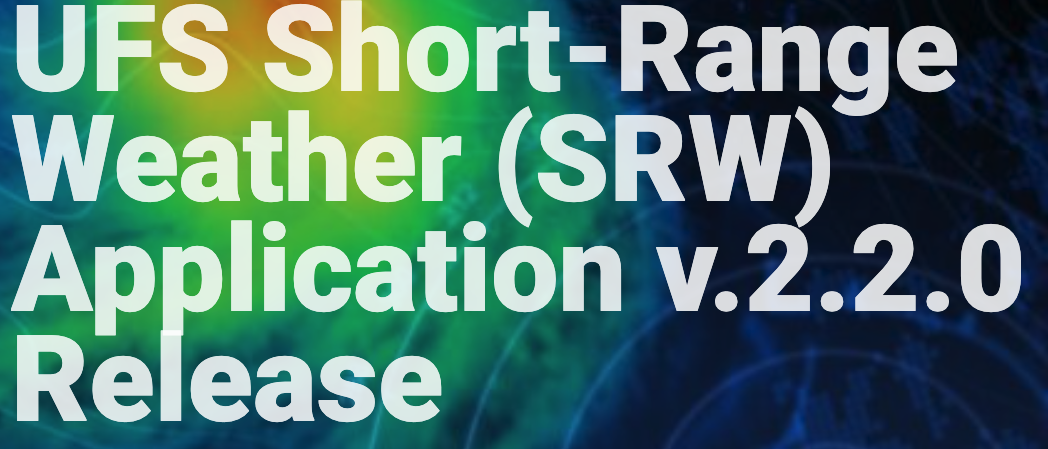Announcing the release of UFS Short-Range Weather App v2.2.0

 Code sharing enables innovations in numerical weather prediction science
Code sharing enables innovations in numerical weather prediction science
The Earth Prediction Innovation Center (EPIC) and the Unified Forecast System (UFS) community have released the Unified Forecast System (UFS) Short-Range Weather (SRW) Application v2.2.0. The Unified Forecast System (UFS) is a community-based, comprehensive Earth modeling system with shared science components and software infrastructure. It is designed to be the source system for NOAA’s operational numerical weather prediction applications while enabling research, development, and contribution opportunities for the broader weather enterprise.
The UFS SRW Application is designed for short-range weather forecasts at regional scales and time scales from minutes to several days. This modeling system includes all of the pre- and post-processing capabilities needed to run an end-to-end forecast, from defining a model grid to generating graphics plots of the model forecast field output. The NOAA Global Systems Laboratory (GSL) was a co-lead on the release.
The UFS SRW 2.2.0 uses the atmosphere and land components of the UFS and is designed for short-range regional forecasts located anywhere on the globe. This timeframe is important to help forecasters issue life-saving weather and water forecasts in the U.S. during extreme events like blizzards, tornadoes, and hurricanes. The UFS SRW App can also be run on Amazon Web Services where the modeling community can run the App and modify the code to test their own innovations which may lead to advances in forecast skill. This release is part of the ongoing effort to transition to an open community development paradigm and accelerate the advancement of environmental prediction models. The latest release of the application is now available through GitHub to the public.
GSL, Cooperative Institute for Research in Environmental Sciences (CIRES), and Cooperative Institute for Research in the Atmosphere (CIRA) teams worked on many parts of the UFS SRW App v2.2.0 release including implementing new physics suites and physics schemes, and innovations and improvements to existing physics. The release also includes expansion of several test cases and suites for workflow end-to-end (WE2E) testing, improved verification capabilities, comprehensive documentation, and code management.
The UFS SRW application also serves as the foundation for NOAA’s future convection-allowing ensemble forecast system, known as the Rapid Refresh Forecast System, which builds on the existing High-Resolution Rapid Refresh model known as the HRRR. Through participation in the UFS, expert members of the broader weather community are contributing to the enhancement and development of the RRFS.
Future work will expand the capabilities of the Application to include data assimilation (DA) and a forecast restart/cycling capability.
The SRW Application Release Working Group includes members from NOAA laboratories, centers, cooperative institutes, and community partners. This release was funded by the NOAA Weather Program Office’s Earth Prediction Innovation Center Program (EPIC), Fire Weather and Air Quality, and Joint Technology Transfer Initiative (JTTI) programs; the National Weather Service Office of Science and Technology Integration (OSTI) modeling programs; and various Disaster Supplemental funding sources.
Contributors [in alphabetic order]: The SRW Application Release Working Group includes members from NOAA laboratories, centers, cooperative institutes, and community partners — notably the Air Resources Laboratory (ARL), CIRES, CIRA, the Cooperative Institute for Satellite Earth System Studies (CISESS), the Cooperative Institute for Severe and High-Impact Weather Research and Operations (CIWRO), the Developmental Testbed Center (DTC), the Earth Prediction Innovation Center (EPIC), the Geophysical Fluid Dynamics Laboratory (GFDL), the Global Systems Laboratory (GSL), the National Center for Atmospheric Research’s (NCAR’s) Climate and Global Dynamics (CGD) Laboratory and Research Application Laboratory (RAL), the National Centers for Environmental Prediction/Environmental Modeling Center (NCEP/EMC), the National Severe Storms Laboratory (NSSL), and the Physical Sciences Laboratory (PSL).
